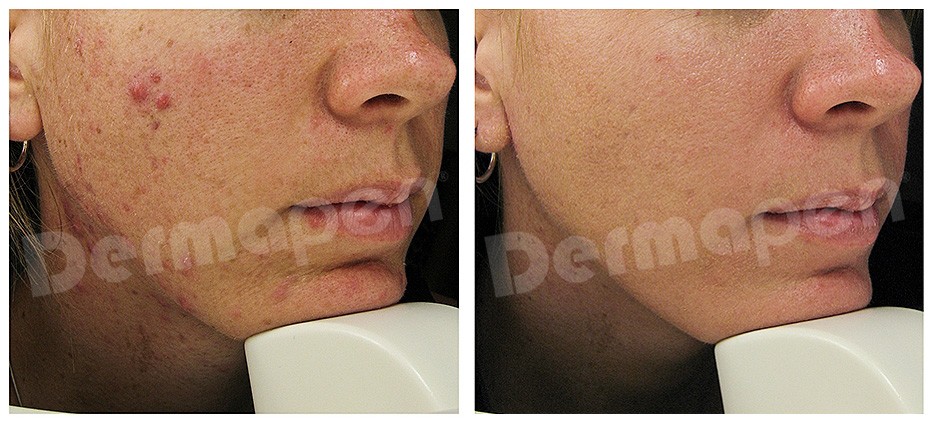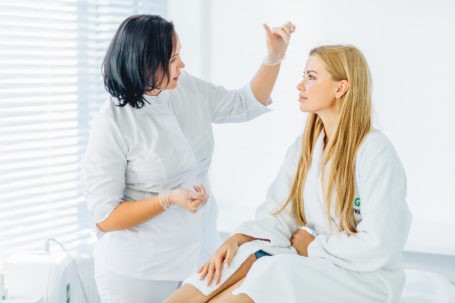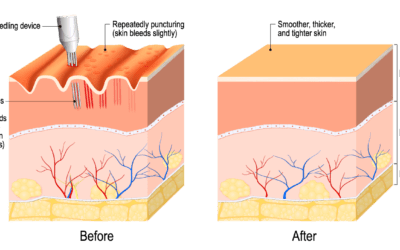Microneedling Acne Scars
Last updated on June 1st, 2023
Micro Needling Acne Scars Treatment there are many treatments for acne scars, each with characteristic side effects. For most treatments, the principle treatment side effect is postinflamatory hyperpigmentation (Fabbrocini et al., 2010) which is most pronounced in darker skin types (Shah and Alexis, 2010). Postinflammatory hyperpigmentation may result from dermabrasion, chemical peels and laser resurfacing.
Acne Scars: Over 90% of adolescents have acne and 1% of the population have acne scars.
Why Acne Scars? Acne scars are created by the wound healing process occurring after the acute process of inflammation, follicular rupture and perifollicular abscess formation.
Types of Acne Scars. The resulting acne scars may be atrophic or hypertrophic (Fabbrocini et al., 2010). Approximately 80% of scars are atrophic associated with a net loss of collagen during the matrix remodeling process. A minority of scars are hypertrophic or have keloid formation. Atrophic scars are classified as:
- Ice pick (70%) – These are the narrow < 2mm punctiform depressions with a “V” cross-section.
- Boxcar (20%) – These are round or oval scars with well-established vertical edges with a wide base and a “U” cross-section.
- Rolling scars (10%) – These wide > 4 mm scars have an “M” cross-section and give an undulating appearance to the skin.
Grade of acne scarring Level of Disease Clinical Features
- Macular Erythematous hyper- or hypo-pigmented flat marks. These do not present a contour defect but rather color problem.
- Mild Mild atrophy or hypertrophy scars that are not obvious at social distances of > 50 cm and may be covered by makeup or facial hair.
- Moderate Moderate atrophic or hypertrophic scarring that is obvious at social distances of > 50 cm and is not covered by makeup or facial hair. Scar will flatten by manual stretching of the skin.
- Severe Severe atrophic or hypertrophic scarring that is obvious at social distances of > 50 cm and is not covered by makeup or facial hair. Scar will not flatten by manual stretching of the skin.
Treatment Type Mechanism – Indication Side Effects
 Chemical Peel Best results with macular scars. Only variable results with icepick and rolling scars. Temporary hyper-pigmentation or irritation.
Chemical Peel Best results with macular scars. Only variable results with icepick and rolling scars. Temporary hyper-pigmentation or irritation.
Dermabrasion Completely removes the epidermis to the papillary or reticular dermis. Will treat icepick and rolling scars. General anesthesia and infection risks. Significant patient downtime. Darker skin may become discolored and blotchy.
Microdermabrasion Removes outer layer of the epidermis. Does not treat deep scars. Only rare complications.
Micro needling acne scars leaves epidermis largely intact. Full effect seen after 6 weeks as mechanism of action is enhanced collagen production. Lowest risk of postinflammatory hyperpigmentation than the other procedures.
Fractional laser Treatment Ablative is more effective than nonablative. Quantifiable improvement of 40 -80% in scar depth. Patient must stop isoretinoin. Dark skin is at risk of postinflammatory hyperpigmentation. Hyperpigmentation using conventional CO2 laser is 36% (Alster and West, 1996)
Micro Needling Acne Scars References
Alster TS, West TB (1996) Resurfacing of atrophic facial acne scars with a high-energy, pulsed carbon dioxide laser. Dermatol Surg 22: 151-155.
Camirand A, Doucet J (1997) Needle dermabrasion. Aesthetic Plast Surg 21: 48-51.
Fabbrocini G, Fardella N, Monfrecola A, Proietti I, Innocenzi D (2009) acne scarring treatment using skin needling. Clin Exp Dermatol 34: 874-879.
Fabbrocini G, Annunziata MC, D’Arco V, De Vita V, Lodi G, Mauriello MC, Pastore F, Monfrecola G (2010) Acne scars: Pathogenesis, classification, and treatment. Dermatol Res Pract 2010: 893080.
Goodman G (2003) Post acne scarring: a review. J Cosmet laser Ther 5: 77-95.
Goodman GJ, Baron JA (2006) Post acne scarring: a qualitative global scarring grading system. Dermatol Surg 32: 1458-1466.
Graber EM, Tanzi EL, Alster TS (2008) Side effects and complications of fractional laser photothermolysis: experience with 961 treatments. Dermatol Surg 34: 301-305.
Jacob CI, Dover JS, Kaminer MS (2001) acne scarring: a classification system and review of treatment options. J Am Acad Dermatol 45: 109-117.
Levy LL, Zeichner JA (2012) Management of acne scarring, Part II: A comparative review of non-laser based, minimally invasive approaches. Am J Clin Dermatol 13:331-340.
Shah SK, Alexis AF (2010) Acne in skin of color: practical approaches to treatment. J Dermatolog Treat 21:206-211.
Image Credit: Tony Chu, Professor of Dermatology-Hammersmith Hospital London, UK 4 Treatments (1.5 MM) 4 weeks apart.
Find certified Dermapen microneedling professionals
Dermapen® Microneedling Devices are exclusively sold to Medical and Skin Care Professionals. Use the form to the right to get started finding a Certified Dermapen® practitioner in your area.
Enter your location information to find a Dermapen Skin Care Professional.
Error: Contact form not found.
Want to become a Dermapen Practitioner?
Medical Clinics and Spas can offer their patients the worlds most advanced microneedling treatments with Dermapen
Microneedling Treatments
The Dermapen Microneedling Pen provides an unparalleled response through the segmented delivery of microneedles, creating micro injuries to the epidermis (outer layer of skin) and dermis (the inner layer of skin). As a result, the micro injuries encourage the body’s innate ability to repair itself.
Every Dermapen tip is outfitted with 12 needles and features our patented technologies, which include SureSpace™ and SafLok™. Accordingly, these safety enhancements can be found in every Dermapen needle tip and pen.
Furthermore, by using SureSpace™ and SafLok™ microneedling pen technologies, practitioners can deliver their patients the safest microneedling treatment possible, while getting the best microneedling results for their patients.




Comments are closed.